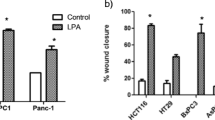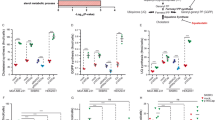Abstract
Phorbol ester protein kinase C (PKC) activators and PKC isozyme over-expression have been shown to significantly reduce intracellular accumulation of chemotherapeutic drugs, in association with the induction of multidrug resistance (MDR) in drug-sensitive cancer cells and enhancement of drug resistance in MDR cancer cells. These observations constitute solid evidence that PKC plays a significant role in the MDR phenotype of cancer cells. PKC-catalyzed phosphorylation of the drug-efflux pump P-glycoprotein was recently ruled out as a contributing factor in MDR. At present, the sole drug transport-related event that has been identified as a component of the role of PKC in MDR is PKC-induced expression of the P-glycoprotein-encoding gene mdr1. The objective of this study was to test the hypothesis that PKC can modulate the uptake of chemotherapeutic drugs in cancer cells independently of P-glycoprotein. We analyzed the effects of selective PKC activators/inhibitors on the uptake of radiolabelled cytotoxic drugs by cultured human colon cancer cells that lacked P-glycoprotein activity and did not express the drug efflux pump at the level of message (mdr1) or protein. We found that the selective PKC activator 12-O-tetradecanoylphorbol-13-acetate (TPA) significantly reduced uptake of [14C] Adriamycin and [3H] vincristine in human colon cancer cells devoid of P-glycoprotein activity, and that PKC-inhibitory N-myristoylated PKC-α pseudosubstrate synthetic peptides potently and selectively induced uptake of the cytotoxic drugs in the phorbol ester-treated and non-treated colon cancer cells. TPA treatment of the cells did not induce expression of either P-glycoprotein or its message mdr1. In contrast with [14C]Adriamycin and [3H] vincristine uptake, [3H] 5-fluorouracil uptake by the cells was unaffected by TPA and reduced by the PKC-inhibitory peptides. These results indicate that PKC activation can significantly reduce the uptake of multiple cytotoxic drugs by cancer cells independently of P-glycoprotein, and that N-myristoylated PKC-α pseudosubstrate peptides potently and selectively induce uptake of multiple cytotoxic drugs in cultured human colon cancer cells by a novel mechanism that does not involve P-glycoprotein and may involve PKC isozyme inhibition. Thus, N-myristoylated PKC-α pseudosubstrate peptides may offer a basis for the development of agents that reverse intrinsic drug resistance in human colon cancer.
Similar content being viewed by others
References
Fine RL, Patel J, Chabner BA: Phorbol esters induce multidrug resistance in human breast cancer cells. Proc Natl Acad Sci 85:582–586, 1988
Newton AC: Protein kinase C: Structure, function, and regulation. J Biol Chem 270:28495–28498, 1995
O'Brian CA, Ward NE, Gravitt KR, Fan D: Role of protein kinase C in multidrug resistance. Cancer Treatment Res 73:41–55, 1994
Chambers TC, McAvoy EM, Jacobs JW, Eilon G: Protein kinase C phosphorylates P-glycoprotein in multidrug resistant human KB carcinoma cells. J Biol Chem 265:7679–7686, 1990
Dong Z, Ward NE, Fan D, Gupta KP, O'Brian CA: In vitro model for intrinsic drug resistance: Effects of protein kinase C activators on the chemosensitivity of cultured human colon cancer cells. Mol Pharmacol 39:563–569, 1991
Yu G, Ahmad S, Aquino A, Fairchild CR, Trepel JB, Ohno S, Suzuki K, Tsuruo T, Cowan KH, Glazer RI: Transfection with protein kinase C-α confers increased multidrug resistance to MCF7 cells expressing P-glycoprotein. Cancer Commun 3:181–189, 1991
Posada JA, McKeegan EM, Worthington KF, Morin MJ, Jaken S, Tritton TR: Human multidrug resistant KB cells overexpress protein kinase C: Involvement in drug resistance. Cancer Commun 1:285–292, 1989
O'Brian CA, Fan D, Ward NE, Dong Z, Iwamoto L, Gupta KP, Earnest LE, Fidler IJ: Transient enhancement of multidrug resistance by the bile acid deoxycholate in murine fibrosarcoma cells in vitro. Biochem Pharmacol 41:797–806, 1991
Blobe GC, Sachs CW, Khan WA, Fabbro D, Stabel S, Wetsel WC, Obeid LM, Fine RL, Hannun YA: Selective regulation of expression of protein kinase C (PKC) isoenzymes in multidrug resistant MCF7 cells. J Biol Chem 268:658–664, 1993
Chamber TC, Pohl J, Raynor RL, Kuo JF: Identification of specific sites in human P-glycoprotein phosphorylated by protein kinase C. J Biol Chem 268:4592–4595, 1993
Germann UA, Chambers TC, Ambudkar SV, Licht T, Cardarelli CO, Pastan I, Gottesman MM: Characterization of phosphorylation-defective mutants of human P-glycoprotein expressed in mammalian cells. J Biol Chem 271:1708–1716, 1996
Goodfellow HR, Sardini A, Ruetz S, Callaghan R, Gros P, McNaughton PA, Higgin CF: Protein kinase C-mediated phosphorylation does not regulate drug transport by the human multidrug resistance P-glycoprotein. J Biol Chem 271:13668–13674, 1996
Gupta KP, Ward NE, Gravitt KR, Bergman PJ, O'Brian CA: Partial reversal of multidrug resistance in human breast cancer cells by an N-myristoylated protein kinase C-α pseudosubstrate peptide. J Biol Chem 271:2102–2111, 1996
Bergman PJ, Gravitt KR, O'Brian CA: An N-myristoylated protein kinase C-alpha pseudosubstrate peptide that functions as a multidrug resistance reversal agent in human breast cancer cells is not a P-glycoprotein substrate. Cancer Chem Pharm 40:453–456, 1997
Morikawa K, Walker SM, Jessup JM, Fidler IJ: In vivo selection of highly metastatic cells from surgical specimens of different primary human colon carcinomas implanted in nude mice. Cancer Res 48:1943–1948, 1988
Fan D, Beltran PJ, Wang Y, Bucana CD, Yoon S, DeGuzman AC, Fidler IJ: Cell density-dependent regulation of mdr1 gene expression in murine colon cancer cells. Int J Oncol 9:865–878, 1996
Galski H, Sullivan M, Willingham MC, Chin KV, Gottesman MM, Pastan I, Merlino GT: Expression of a human multidrug resistance cDNA (mdr1) in the bone marrow of transgenic mice: resistance to daunomycin-induced leukopenia. Mol Cell Biol 9:4357–4363, 1989
Fort P, Marty L, Piechaczyk M, Sabronty DE, Dani C, Jeanteur P, Blanchard JM: Various rat adult tissues express only one major mRNA species from the glyceraldehyde-3-phosphate-dehydrogenase multigenic family. Nucleic Acids Res 13:1431–1442, 1985
Feinberg AP, Vogelstein B: A technique for radiolabelling DNA restriction endonuclease fragments to high specific activity. Anal Biochem 132:6–14, 1983
Gravitt KR, Ward NE, Fan D, Skibber JM, Levin B, O'Brian CA: Evicdence that protein kinase C-α activation is a critical event in phorbol ester-induced multiple drug resistance in human colon cancer cells. Biochem Pharmacol 48:375–381, 1994
Cardarelli CO, Aksentijevich I, Pastan I, Gottesmann MM: Differential effects of P-glycoprotein inhibitors on NIH3T3 cells transfected with wild-type (G185) or mutant (V185) multidrug transporters. Cancer Res 55:1086–1091, 1995
Ward NE, O'Brian CA: Inhibition of protein kinase C by N-myristoylated peptide substrate analogs. Biochemistry 32:11903–11909, 1993
Chambers TC, Zheng B, Kuo JF: Regulation by phorbol ester and protein kinase C inhibitors, and by a protein phosphatase inhibitor (okadaic acid), of P-glycoprotein phosphorylation and relationship to drug accumulation in multidrug-resistant human KB cells. Mol Pharmacol 41:1008–1015, 1992
Aftab DT, Yang JM, Hait WN: Functional role of phosphorylation of the multidrug transporter (P-glycoprotein) by protein kinase C in multidrug-resistant MCF-7 cells. Oncol Res 6:59–70, 1994
Chaudhary PM, Roninson IB: Activation of MDR1 (P-glycoprotein) gene expression in human cells by protein kinase C agonists. Oncol Res 4:281–290, 1992
Hunter T, Ling N, Cooper JA: Protein kinase C phosphorylation of the EGF receptor at a threonine residue close to the cytoplasmic face of the plasma membrane. Nature 311:480–483, 1984
Morrison P, Takishima K, Rosner MR: Role of threonine residues in regulation of the epidermal growth factor receptor by protein kinase C and mitogen-activated protein kinase. J Biol Chem 268:15536–15543, 1993
Morrison P, Saltiel AR, Rosner MR: Role of mitogen-activated protein kinase in regulation of the epidermal growth factor receptor by protein kinase C. J Biol Chem 271:12891–12896, 1996
Seedorf K, Shearman M, Ullrich A: Rapid and long-term effects of protein kinase C on receptor tyrosine kinase phosphorylation and degradation. J Biol Chem 270:18953–18960, 1995
Mayer RJ: Chemotherapy for metastatic colon cancer. Cancer 70:1414–1424, 1992 (Suppl.)
Hamilton JM: Adjuvant therapy for gastrointestinal cancer. Curr Opin Oncol 6:435–440, 1994
Author information
Authors and Affiliations
Rights and permissions
About this article
Cite this article
Bergman, P.J., Gravitt, K.R., Ward, N.E. et al. Potent induction of human colon cancer cell uptake of chemotherapeutic drugs by N-myristoylated protein kinase C-α (PKC-α) pseudosubstrate peptides through a P-glycoprotein-independent mechanism. Invest New Drugs 15, 311–318 (1997). https://doi.org/10.1023/A:1005933401603
Issue Date:
DOI: https://doi.org/10.1023/A:1005933401603




